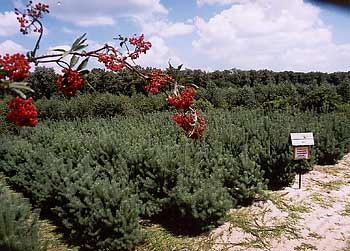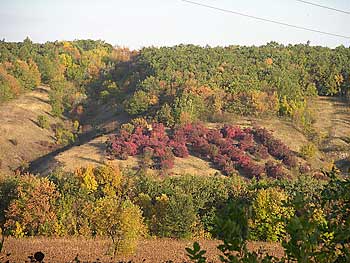


P.I. Lakyda, I.F. Buksha and V.P. Pasternak
P.I. Lakyda and I.F. Buksha are in the Forest Management Department of the National Agricultural University of Ukraine, Kyiv, Ukraine.
V.P. Pasternak is in the Laboratory of Forest Monitoring and Certification, Ukrainian Research Institute of Forestry and Forest Melioration, Kharkiv, Ukraine.
One country’s hopes for attracting investment in afforestation and reforestation under the Kyoto Protocol.
Ukraine has good potential for hosting afforestation projects to increase carbon sequestration (shown, a young pine plantation) |
 |
UKRAINIAN RESEARCH INSTITUTE OF FORESTRY AND FOREST MELIORATION |
The Kyoto Protocol engages countries to reduce greenhouse gases. Ukraine ratified the United Nations Framework Convention on
Climate Change in 1997 and the Kyoto Protocol in early 2004. The protocol stipulates a number of “flexibility mechanisms”, among which the most promising for Ukraine is Joint Implementation. In Joint Implementation, a developed country can offset some of its domestic emissions by investing in a project in another developed country or country with economy in transition in exchange for emission reduction credits. The pilot phase of Joint Implementation, known as Activities Implemented Jointly, has been in effect since 1995.
The Kyoto Protocol allows Joint Implementation projects in forest management, reforestation and afforestation. Such projects in forestry are already under way in several Eastern Europe countries. For example, in the Russian Federation a pilot project for afforestation of the Saratov area, carried out in partnership with the University of Oregon, United States, in the framework of Activities Implemented Jointly, has created, protected and monitored 900 ha of pine forests since 1994. A similar project was prepared in 1996 to create 2 000 ha of forests in the Vologda region. In Romania, the World Bank-managed Prototype Carbon Fund has signed a project agreement to finance afforestation of 6 852 ha of degraded agricultural lands.
Ukraine has greater potential for hosting forestry projects to increase carbon sequestration through afforestation activities than most European countries (Shevchuk et al., 2001). Forest cover in Ukraine is one of the lowest in Europe, at 16.5 percent, compared with 46 percent for Europe as a whole (FAO, 2001). The country has significant lands unsuitable for agricultural use which have potential for afforestation; according to the Ukrainian Academy of Agrarian Sciences, about 10 million hectares should be excluded from agricultural use and converted to forests or meadows (Bulygin, 2001). Under the State programme “Forests of Ukraine 2002–2015”, new forests are to be created on more then 560 000 ha, and their biomass should contain more than 20 million tonnes of carbon by 2050 (Schelhaas et al., 2004). However, to achieve an optimum level of forest cover for the country (19 to 20 percent), it would be necessary to create about 2.5 million hectares of forests. Significant financing is necessary for such a great afforestation effort, so the opportunity to attract additional investment through Joint Implementation under the Kyoto Protocol is very important to Ukraine.
Long-term research on carbon accumulation in Ukrainian forests testifies to the significant potential of the country’s forests in regard to deposition of carbon. The average carbon density per hectare of forest, 65 tonnes per hectare in 1996, is higher than in neighbouring countries (45, 46, 53 and 63 tonnes per hectare in Moldova, the European part of the Russian Federation, Belarus and Lithuania, respectively in 1996) (Lakyda, Nilson and Shvidenko, 1996) and increased by 17 percent between 1988 and 1996 (Buksha, 2002). According to estimates made on the basis of State forest assessments, the volume of deposited carbon in Ukraine’s forest stands increased by almost 40 percent between 1983 and 1996 (Table 1), mainly as a result of change in age structure and forest area. Between 1990 and 2001 almost 140 000 ha of new forests were created, and these forest stands currently store about 230 000 tonnes of carbon (Buksha, 2002).
Pilot afforestation projects for a total of 5 120 ha in central, eastern and western Ukraine (Table 2) have been developed in a series of regional seminars held by the State Committee of Forestry together with the Initiative on Climate Change and the Ukrainian Research Institute of Forestry and Forest Melioration. The seminars were prepared by leading national and foreign experts on climate change in forestry and attended by chief foresters and experts from regional forest associations, State forestry enterprises, research institutions and ministries. The seminars presented recent forest-related decisions of the international climate change negotiations and provided practical training concerning preparation of projects on carbon sequestration in forestry, including planning, preparation, implementation, monitoring and verification. Regional working groups prepared carbon sequestration projects using different approaches and methods, which were all judged by experts to be realistic and scientifically sound. Potential investors include the Prototype Carbon Fund and organizations from Canada, Japan and the Netherlands.
The areas selected for afforestation under the projects are additional to those where afforestation was already scheduled by the State Committee of Forestry. The project designers mainly selected lands not suitable for agricultural use which had not been forested for at least 50 years. Depending on site conditions, the tree species composition was selected to form forests close to natural. One of the main elements of support for these projects is monitoring of carbon sequestration, which should guarantee an appropriate estimation of the carbon sequestration capacity based on techniques recognized at the international level.
For Polissya, a project was designed to regenerate forests on lands polluted by radioactive nuclides after the Chernobyl catastrophe. In addition to increasing carbon sequestration, the creation of forests on these lands will help prevent distribution of radioactive nuclides by fixing them in forest vegetation and preventing soil erosion. The State Committee of Forestry of Ukraine and the World Bank have signed a memorandum concerning the performance of this project, according to which about 15 000 ha in the northern part of the country should be afforested.
The economics of the projects were calculated for a period of 30 to 60 years (depending on the species structure of the forests). By rough calculations, during the projects the new forests will sequester 546 800 tonnes of carbon, or 107 tonnes of carbon per hectare of the lands covered by forest vegetation. The new forest stands will absorb the most carbon during the project term but will continue to do so even after the projects end. These new forests will not only sequester carbon; they will also enhance biodiversity, protect soils against wind and water erosion and be used for recreation. After the project term, when the trees have reached exploitable age, the forests will be used for long-term production.
TABLE 1. Dynamics of carbon in above- and below-ground forest biomass in Ukraine (excluding soil, deadwood and litter) |
|||||
Year |
Forest area |
Volume |
Average volume |
Carbon density |
Carbon volume |
1983 |
8.59 |
1 240 |
144 |
51 |
441 |
1988 |
8.62 |
1 320 |
152 |
54 |
469 |
1996 |
9.40 |
1 736 |
186 |
65 |
615 |
Source: Buksha, 2002. | |||||
| TABLE 2. Proposed demonstration projects on afforestation under the Kyoto Protocol | |||
Region |
Area |
Volume of CO2 absorption |
Cost of absorption of 1 tonne of CO2 |
Polissya |
1 299 |
138 323 |
5.7 |
Central Ukraine |
933 |
131 147 |
4.3 |
Western Ukraine |
1 127 |
80 288 |
6.9 |
Eastern Ukraine |
1 761 |
197 026 |
6.0 |
Total/average |
5 120 |
546 784 |
5.8 |
New forests planted to sequester carbon will also provide other benefits such as protecting soils against erosion |
 |
UKRAINIAN RESEARCH INSTITUTE OF FORESTRY AND FOREST MELIORATION |
 Bibliography
Bibliography
Buksha, I. 2002. Contribution of Ukraine’s forestry to minimize climate change risk. In Some aspects of global climate change in Ukraine, pp. 132–148. Kyiv, Ukraine, FADA. [In Ukrainian]
Bulygin, S. 2001. General conception of forming of environmentally sustainable and high productive agrolandscapes. In Bulletin of the conference “Condition of Land Resources of Ukraine: Problems and Ways for Solution”, pp. 69–74. Kharkiv, Ukraine. [In Ukrainian]
FAO. 2001. Global Forest Resources Assessment 2000 – main report. FAO Forestry Paper No. 140. Rome.
Lakyda, P., Nilson, S. & Shvidenko, A. 1996. Estimation of forest phytomass for selected countries of the former European USSR. Biomass and Bioenergy, 11(5): 371–382.
Schelhaas, M.J., Cerny, M., Buksha, I., Pasternak, V., Cienciala, E., Csoka, P., Galinski, W., Karjalainen, T., Kolozs, L., Nabuurs, G.J., Pussinen, A., Sodor, M. & Wawrzoniak, J. 2004. Scenarios on forest management in the Czech Republic, Hungary, Poland and Ukraine. EFI Research Report 17. Leiden, the Netherlands, Brill Academic Publishers.
Shevchuk, V., Trofimova, I., Trofimchuk, O., Ivanenko, N., Parasuk, N., Kublanov, S. & Tolkachov, V. 2001. Issues and strategy for fulfilling United Nations Framework Convention on Climate Change. Kyiv, Ukraine, Ukrainian Institute of Environment and Resources Research. [In Ukrainian]